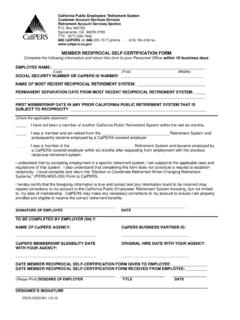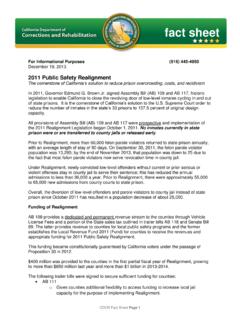Transcription of Fact Sheet: Vicarious Trauma Definition of Vicarious ...
1 How Being Trauma -Informed Improves Criminal Justice System Responses Policy Research Associates, Inc. 1 Fact Sheet: Vicarious Trauma Vicarious Trauma was first identified in 1980s as the cost of caring (Figley, 1982). It is sometimes referred to as compassion fatigue (Perlman & Saakvitne, 1995). Symptoms can parallel those of PTSD re-experiencing, numbness, avoidance, and persistent arousal (Figley, 1996). Professionals working with survivors of Trauma ( sexual assault) report changes to how they see the world for example, that the world is not just or safe (Salston & Figley, 2003).
2 Professionals with previous Trauma histories show significantly higher secondary Trauma symptoms than those with no Trauma histories (Folette, Polusny, & Milbeck, 1994). Definition of Vicarious Trauma The emotional residue of exposure to traumatic stories and experiences of others through work; witnessing fear, pain, and terror that others have experienced; a pre-occupation with horrific stories told to the professional (American Counseling Association, 2016) Sometimes referred to as secondary traumatization, secondary stress disorder, or insidious Trauma (ACA, 2016) Included in the DSM-5 as part of the cluster of Trauma and stressor-related disorders Vicarious Trauma is not the same as burnout Definition of Compassion Fatigue Beyond empathy, it is also known as secondary traumatic stress (STS)
3 , a condition characterized by a gradual lessening of compassion over time. Can happen quite quickly (as opposed to Vicarious Trauma or burnout) and is responsive to evidence-based treatment interventions Definition of controlled Empathy Constant monitoring of emotions so as to not react to stories and testimony, absorbing the information without showing emotion Requires vigorous neurological activity Autonomic empathy involves both sides of the brain, reacting to stories with appropriate emotion, allows brain to react.
4 Release tension controlled empathy taking control of the empathic response and taxing the right hemisphere of the brain Definition of Burnout Long term stress reaction and process that occurs among professionals who work with people in some capacity (Freudenberger, 1974; Maslach, 1982; Maslach and Schaufeli, 1993) Can be brought about by workplace conflict, overload of responsibilities, perception of inequality and inadequate rewards, and consistent exposure to traumatic materials (Chamberlain and Miller, 2008) Emotional exhaustion, depersonalization, and reduced personal accomplishment Feelings of being emotionally overextended, depleted or self-doubt Increasing disillusionment (Edelwich and Brodsky, 1980)
5 End result depersonalization and apathy How Being Trauma -Informed Improves Criminal Justice System Responses 2 Policy Research Associates, Inc. Workplace Symptoms of Vicarious /Secondary Trauma (BOLO) Behavioral: Frequent job changes Tardiness Free floating anger/irritability Absenteeism Irresponsibility Overwork Irritability Exhaustion Talking to oneself (critical symptom) Going out to avoid being alone Dropping out of community engagements Rejecting closeness Interpersonal: Staff conflict Blaming others Conflictual engagement Poor relationships Poor communication Impatience Avoidance of working with clients with Trauma histories Lack of collaboration Withdrawal and isolation from colleagues Change in relationships with colleagues Difficulty having rewarding relationships Personal values/beliefs.
6 Dissatisfaction Negative perception Loss of interest Apathy Blaming others Lack of appreciation Lack of interest and caring Detachment Hopelessness Low self-image Worried about not doing enough Questioning frame of reference world view, spirituality, identity Disruption in self-capacity Disruption in needs, beliefs, and relationships Job performance: Low motivation Increased errors Decreased quality Avoidance of job responsibilities Over-involvement in details/perfectionism Lack of flexibility How Being Trauma -Informed Improves Criminal Justice System Responses Policy Research Associates, Inc.
7 3 Personal Symptoms of Vicarious Trauma ( , what others won t see) (ACA) Behavioral: Sleep disturbances Nightmares Appetite changes Hypervigilance Exaggerated startle response Losing things Clumsiness Self-harm behaviors Negative coping smoking drinking, acting out Physical: Panic symptoms sweating, rapid heartrate, difficulty breathing, dizziness Aches and pains Weakened immune system Cognitive: Minimization of Vicarious Trauma Lowered self-esteem and increased self-doubt Trouble concentrating Confusion/disorientation Perfectionism Racing thoughts Loss of interest in previously-enjoyed activities Lack of meaning in life Thoughts of harming yourself or others Emotional: Helplessness and powerlessness Survivor guilt Numbness Oversensitivity Emotional unpredictability Fear Anxiety Sadness and/or depression Social.
8 Withdrawal and isolation Loneliness Irritability and intolerance Distrust Projection of blame and rage Decreased interest in intimacy Change in parenting style (overprotective) How Being Trauma -Informed Improves Criminal Justice System Responses 4 Policy Research Associates, Inc. Interventions for Vicarious Trauma ABC s: Awareness, Balance, and Connection (ACA) Individual Level: Monitor yourself eat well, rest, and exercise Self-care seek balance, engage in outside activities Set professional and personal boundaries Take advantage of professional development opportunities Utilize viable, evidence-based treatments for Vicarious Trauma /secondary traumatic stress that focus on changes in cognitive processes Organizational/Social Level.
9 Reduce system causes of Vicarious Trauma , secondary traumatic stress, and burnout such as workload and exposure to challenging cases Provide critical incidents debriefing Work with area Employee Assistance Programs (EAP) to identify areas of improvement such as in-service trainings on self-care or counseling Provide sabbaticals, professional education, community service, and public speaking opportunities Provide a Psychologist Peer Advocate a specially-trained therapist to assist with cognitive changes resulting from Vicarious Trauma Further Reading and References American Counseling Association ( ).
10 Fact Sheet #9: Vicarious Trauma . Downloaded 4/20/16 Chamberlain, J., and Miller, M. K. (2008). Stress in the courtroom: Call for research. Psychiatry, Psychology, and Law, 15, 237-250. Edelwich, J., and Brodsky, A. (1980). Burnout: States of disillusionment in the helping professions. NY: Human Resources Press. Figley, C. R. (1982). Traumatization and comfort: Close relationships may be hazardous to your health. Keynote presentation, Lubbock TX. Figley, C. R. (1996). Compassion fatigue as a secondary traumatic stress disorder: An overview.











